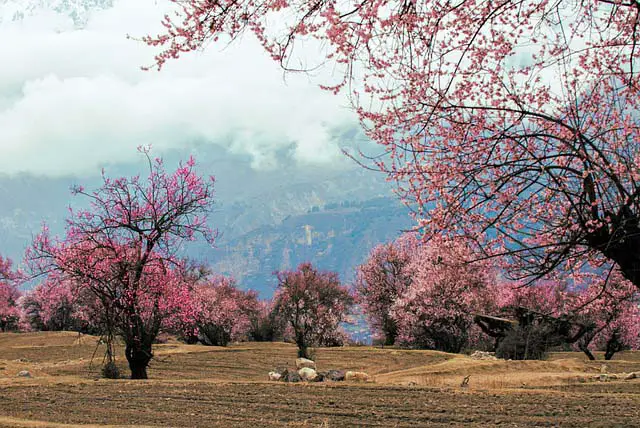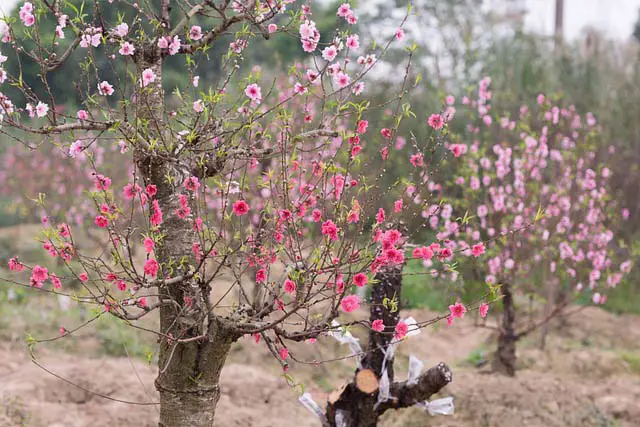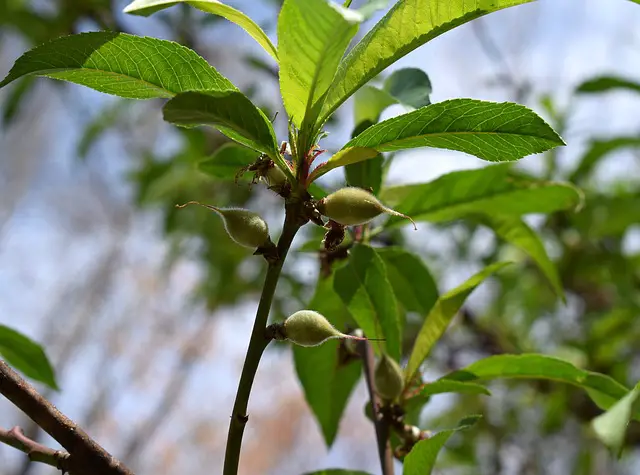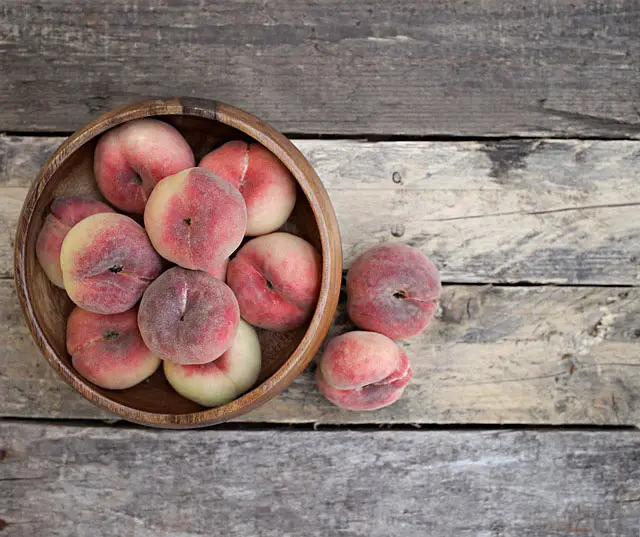
I live in an area that is great for growing peaches…mostly. Although our weather seems to work well for peach trees, the hot and humid climate also means problems with pests and disease. Talking to some neighbors, I’ve found that some people replace their peach trees after only 7 years! That can’t be right…it hardly seems worth the work.
My peach trees are only 2-3 years old. They’ve barely begun producing peaches, and I hate to think their life is halfway over. After doing some digging (pun intended), I’ve learned a lot more about how long peach trees live and produce fruit, and what I can do to help mine keep fruiting as long as possible.
Peach trees can live and fruit for 15-20 years in a home orchard. Disease pressure and other environmental factors may decrease lifespan. Peak fruiting years are typically years 6 to 12, but a well-cared-for tree can be productive for 20 years or more.
The reality is, the lifespan of a peach tree is affected by several factors. Let’s take a look at what to expect from a backyard peach tree, and how to help it thrive as long as possible.
The Lifespan of a Peach Tree
Peach trees begin fruiting sometime between the ages of 2 and 4, and the first robust crop of peaches will happen in year 4 or 5. Its best, most prolific fruiting years are probably between year 6 and year 10-12, but a peach tree can continue providing a good harvest well beyond that.
A lot of commercial peach orchards will replace their peach trees after 12-15 years because they are trying to balance maintenance costs with potential profits. It’s more costly to maintain the production of an older tree than a younger one, so it makes sense for older trees to be replaced.

In a backyard orchard, peach trees can produce a good crop for much longer, 15-20 years or more. As long as the trees are well cared for – good site selection, watering practices, pruning, and pest and disease prevention – they should continue to thrive. Anecdotally, many home peach growers have older trees that are still producing large, delicious peaches after 30 or 40 years.
There are a couple of caveats, however. In hot and humid areas (such as where I live), the disease and pest pressure for peach trees is much greater than in other climates. Even with good spraying and pruning practices, this often means a somewhat shorter lifespan for peach trees. (Read about dormant peach tree spraying and how to do it here.)
Generally, peach trees will grow less vigorously as they age. The amount of fruiting wood decreases as the tree gets larger and older (peach trees fruit on one-year-old growth). An old peach tree can be invigorated with pruning practices (specifically, cutting it back to 3-year or older wood to encourage more fruiting shoots), but at a certain point it may be better to replace the tree.
For most home growers, a single well-established peach tree probably grows more peaches than a family could ever eat. Even if the fruiting vigor of the tree decreases as it ages, as long as the fruit is good, it will still provide enough peaches to go around for many years.
Determining the Age of a Peach Tree
To estimate how old a peach tree is, check the height, width, and the amount and length of new growth on the tree. Peach trees grow about a foot per year. A standard, unpruned peach tree can grow to be about 25 feet, while dwarf peach trees stay under about 6 feet. If a peach tree is close to these maximum heights, then it is probably an older tree.

The width, or spread of the branches, tends to correspond to the height (so, 25 feet for standard varieties, and 6 feet for dwarf varieties). If your tree is measuring very wide, then it can give you a clue about its age.
The size of the crop can also be informative. As mentioned above, peach trees fruit less as they age. If you know how the tree has been fruiting for the last several years, you can determine if the tree’s vigor is declining. If the crop is very robust then the tree is probably somewhere between 6 and 18 years old. The size of the tree can help narrow down the age further.
Check the amount and length of new growth in the spring. If the tree is in its peak fruiting years (between 6 and 12, say), then the shoots should be 12 to 24 inches long. If the new growth is much shorter, perhaps between 4 to 8 inches, then the tree is probably getting quite old.
Is the fruiting growth only up high on the ends of long, leggy branches? Then the peach tree is most likely past its best fruiting years, and it may need to be replaced.
Remember also that a tree that has not been well cared for may grow poorly or not fruit well. The age of the tree is not the only factor that affects fruiting and overall tree health. Poor watering habits, lack of pruning, or heavy disease pressure can weaken the tree over time and affect fruit production. (See 10 Reasons You Need to Prune Your Peach Tree to learn about why pruning is essential.)

How to Tell if a Peach Tree is Dying
For the most part, a peach tree that is reaching the end of its life will slowly fade. Its decline will probably be gradual, showing less new growth and fewer peaches each season.
Some trees may fall victim to peach tree short life disease, which looks like the sudden wilting of some branches or even the entire tree shortly after bloom. This disease is really a combination of other issues, such as cold weather stress and bacterial canker. Pruning too severely at the wrong time, or other care issues (soil drainage, inconsistent watering) can also shock the tree into wilting. For more on how to properly prune a peach tree, see A Simple Guide to Pruning Peach Trees for Maximum Harvest.
Symptoms of pests (such as peach tree borer, beetles, mites, and aphids) and diseases (such as leaf curl, peach scab, and brown rot) can make a tree seem like it’s dying. In many cases, gardeners can do a lot to prevent or treat these problems and revive the tree. Good cultural practices, such as site selection, watering, pruning, and fertilizing, will give a peach tree it’s best and longest-fruiting life.
If your peach tree is struggling, read Save Your Dying Peach Tree (in 6 Simple Steps) to find out how to revive it.

